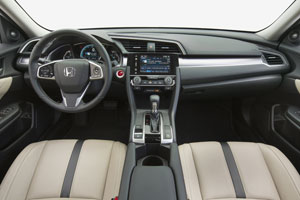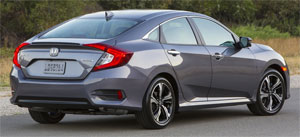2016 Honda Civic Sedan
Like the auto industry itself, it’s been quite a roller coaster of late for the Honda Civic. After its 2011 redesign was met with much disdain by professional car testers, it was hastily re-done just a year later. But, there was only so much they could do. It would take a full reengineering to return the Civic back to its accustomed pedestal. Well now it’s arrived, the 10th generation Honda Civic. So, let’s see if it still deserves its perch.
Redesigning the Honda Civic is surely a tightrope act that even the Flying Wallendas would think twice about. On one hand, people have extremely high expectations of what a Civic is and should be; and on the other hand people want to see lots of improvements that make upgrading worth it. And much like an extremely dangerous high wire act, getting it wrong would be a real disaster.
So, Honda’s goal for the 2016 Civic; like any stunt performer will tell you, is to do all of the prep work possible, leaving nothing to chance. For Honda, that means making it better in every possible way.
Starting it off, there’s some exciting news under the hood for a change, 2 new 4-cylinder engines. A 158-horsepower 2.0-liter, and a 174-horsepower 1.5-liter turbo that spins up 162 lb-ft. of torque.
 The tiny turbo is the more intriguing of the two, and the one we spent the most time with on our first drive opportunity just outside of New York City.
The tiny turbo is the more intriguing of the two, and the one we spent the most time with on our first drive opportunity just outside of New York City.
It’s a little bit laggy with power delivery, clearly feeling more entry level than sporty. But S mode tightens things up, though not so much that you can’t leave it in there all of the time, which we eventually did.
The CVT transmission attached to it does the best job yet of acting like a real automatic, unless you’re keeping it pinned for extended periods a la highway on ramps. And even then, it’s fairly quiet.
Government Fuel Economy Ratings aren’t official, but Honda puts the 1.5-liter at 31-City, 42-Highway, and 35-Combined. The 2.0-liter is remarkably similar at 31-City, 41-Highway, and 35-Combined with a CVT. A 6-speed manual is also available with the 2.0-liter.
Coupe and first time 5-door hatchback body styles will be available, but sales will start off with the bread and butter 4-door sedan.
It’s still highly recognizable, but the new Civic sedan has gotten a lot more stylish with a coupe flavored silhouette, exaggerated fenders, and very aggressive looking face with LED running lights.
 Wheelbase is 1.2-inches longer than before at 106.3; and overall length sees a gain of almost 3-inches. It also sits lower and wider.
Wheelbase is 1.2-inches longer than before at 106.3; and overall length sees a gain of almost 3-inches. It also sits lower and wider.
Of course that adds to interior space which now feels more mid-size than compact. There is plenty of room up front; with more than expected hip, leg, and head room in back, even when equipped with a sunroof. Trunk space also sees a big boost to 15.1 cubic-ft.
Seat comfort is very good and the low seating position is reminiscent of 80’s Japanese cars. Small A-pillars and a big windshield provides the typical Honda great visibility, aided by big side mirrors and a standard backup camera.
The dash is very linear looking without much to break up the flow. Both fit-and-finish and material quality are impressive. Thankfully the two tiered gauge experiment has come to an end.
Despite our turbocharged car’s lag time at launch, we were off to a decent 0-60 time of 7.5 seconds. With both the little turbo cranked and CVT screaming, the ¼-mile passed in a respectable 15.7-seconds at 93 miles-per-hour.
 Through the cones there is a noticeably firmer feel, and a lot less understeer than before. Throw on beefier tires with actual grip, and Honda might really have something here. The steering stiffens up as you go, but it’s a very artificial feel, not necessarily a helpful one.
Through the cones there is a noticeably firmer feel, and a lot less understeer than before. Throw on beefier tires with actual grip, and Honda might really have something here. The steering stiffens up as you go, but it’s a very artificial feel, not necessarily a helpful one.
Civic pricing is up slightly, but remains under 20G’s, with a base, well equipped LX Sedan starting at $19,475. Top Touring trim with the turbo and Honda Sensing accident avoidance package begins at $27,335.
Despite recent journalistic pans, the Civic has remained a compact car sales leader. Still, Honda took no chances this time around, and has updated everything possible in the 2016 Civic. Looks like the 10th time is a charm.
Specifications
- Engine: 1.5 liter turbo
- Horsepower: 174
- Torque: 162 lb-ft.
- 0-60 mph: 7.5 seconds
- 1/4 mile: 15.7 seconds @ 93 mph
- EPA: 31 mpg city/ 42 mpg highway,
2025 Infiniti QX80
Infiniti’s Flagship SUV Sets A Course For Extravagance
This full-size Infiniti QX80 started out as the QX56, a hastily rebadged version of Nissan’s truck-based Armada full-size utility. That was in the early 2000s when the luxury SUV craze was exploding. It wasn’t as much as a game-changer, as it was “try to keep upper”. Now, this new QX80, Infiniti is promising to “Reimagine the luxury SUV”. Let’s see if Infiniti has turned their imaginations into reality.
Well, if over the top is what Infiniti was shooting for in the all-new 2025 QX80, mission accomplished. There’s an overall feeling of extravagance here that we haven’t experienced from Infiniti in quite some time.
It’s not just the open pore ash wood trim with aluminum inlays, 24-speaker audio, and plush quilted leather seating; there’s also nicely integrated ambient lighting, a massive glass roof, plenty of tech, lots of active driving assistance, and even chilled center console storage. Forward of that is a dual touchscreen setup; the top 14.3-inch touchscreen for infotainment sits next to the digital gauge display in a single housing; while just below, there’s a 9-inch one for climate controls.
You are reminded this is still a body-on-frame utility the moment you have to climb up into the cockpit, but there’s also the commanding view of the road that comes with that. Captain’s chairs are standard for the second row, but a three-place bench is optional with all trims except for top Autograph which comes exclusively with these climate-controlled massaging chairs, along with a touchscreen control panel. The third-row experience is great, too, with heated leather seating, and adult size room for three.
Now, there is a whole new experience coming from under the hood. The last gen’s V8 has been replaced with a new twin-turbo 3.5-liter V6 rated at 450 horsepower, 50 over the V8. More notably, torque is up by more than 100 lb-ft to 516. Transmission is a nine-speed automatic, two more gears than last year, with rear-wheel drive standard, four-wheel drive an option. Max tow rating is 8,500-lbs.
And at the test track, it did pull strongly off the line, getting up to speed in a hurry with the 0-60 sprint taking just 6.3 seconds. There is roughly 3 tons of weight to push through the quarter-mile, but that twin-turbo does it well, finishing in 14.7 seconds at 95 mph. Gear changes are incredibly smooth, while not hindering acceleration in any way.
It's an impressive looking utility from any angle.
In panic braking runs, there was some fade and a considerable amount of nosedive, but our average stopping distance of 115 feet is not bad for a vehicle as big and heavy as the QX80. Last gen, the QX80 moved from the Titan truck platform to the global Patrol SUV chassis, which shifted the vibe from budget Escalade to Lexus LX fighter. The attending improvement in ride and handling was the real bonus, and that largely continues for this gen with air suspension and Dynamic Digital Dampers on all but base QX80s. While we could certainly feel all that weight through our cone course, body roll was well-controlled and without significant oversteer or understeer.
It’s an impressive looking utility from any angle, starting right up front with the big “bamboo forest” grille. The overall shape is boxy, but all body panels are smooth; and for better or worse, Infiniti joins the flush door handle fad. Look for its “Artistry In Motion” design theme to work its way down through the rest of the Infiniti lineup. All QX80s ride on 22-inch wheels except for base Pure trim which makes do with 20s.
A full power play includes standard motion-activated rear liftgate and power operation of both second and third row seats, expanding cargo capacity from 22 cu-ft behind the third row to 59 behind the second, and a max of 101.0 cu-ft with both rows folded.
Government Fuel Economy Ratings with four-wheel-drive are not great: 16 city, 19 highway and 17 combined. We averaged 18.6 mpg of premium. That’s a much worse than average Energy Impact Score, using 17.5 barrels of oil annually, with 8.6 tons of CO2 emissions.
Driving such a PUREly LUXEurious SENSORY overload, you’ll probably be expecting people to want your AUTOGRAPH, which we’re guessing is how Infiniti came up with their grade structure; pricing starts with Pure at $84,445 and climbs to $112,590 for Autograph.
The 2025 Infiniti QX80 is a massive SUV that delivers massive amounts of power and luxury. They aimed for the moon here and have clearly blasted themselves into a much more competitive orbit in the big buck, big hauler, sport-utility galaxy.
Specifications
As Tested
- Engine: 3.5-liter twin-turbo V6
- Transmission: 9-speed automatic
- Horsepower: 450
- Torque: 516 lb-ft.
- EPA: 16 City | 19 Highway | 17 Combined
- 0-60 mph: 6.3 seconds
- 1/4 Mile: 14.7 seconds at 95 mph
- Braking, 60-0 (avg.): 115 feet
- MW Fuel Economy: 18.6 mpg (Premium)
























































